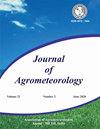气候变化对具有农业和森林生态系统的Shingoda流域水通量动态的影响:综合分析
Q3 Agricultural and Biological Sciences
引用次数: 0
摘要
通过对偏差校正的最高/最低温度和降雨量(RCP4.5)、参考蒸散(ETo)、蒸散(ETc)和径流量的时间序列(1951-2100)的分析,评估了索拉什特拉地区14%农业和75%森林的Shingoda流域的气候变化及其对水通量的影响。结果表明,该流域气候变化显著,日平均气温分别从20世纪下半叶的24.4°C上升到21世纪上半叶和下半叶的26.5°C和27.9°C。与20世纪下半叶相比,21世纪上半叶和下半叶的季节性降雨量分别增加了23.0%和46.33%,径流量分别增加了46.78%和86.40%。然而,同期年参考蒸散量(ETo)下降了-1.41%和-6.5%,作物蒸散量(ETc)下降了-3.2%和-9.8%。分析还显示,20世纪上半叶,向下的水通量(降雨量)不足-16.10%,随后与随后时期的向上通量(ETc)相比,分别盈余8.46%和28.37%。20世纪下半叶向上的水通量不足得到了研究区域地下水位枯竭和海水入侵的证据的支持。本文章由计算机程序翻译,如有差异,请以英文原文为准。
Climate change impacts on water flux dynamics in Shingoda basin having agriculture and forest ecosystems: A comprehensive analysis
An assessment of climate chnage and its impacts on water fluxes in the Shingoda basin of the Saurashtra region having 14% agriculture and 75% forest were made through analysis of time series (1951-2100) of bias corrected maximum/minimum temperature and rainfall (RCP4.5), rreference evapotranspiration (ETo), evapotranspiration (ETc) and runoff. Results showed significant climate changes in the basin, with day mean temperature rising from 24.4°C in the second half of the 20th century to 26.5°C and 27.9°C in the first and second half of the 21st century, respectively. During the first and second half of the 21st century, seasonal rainfall increased by 23.0% and 46.33%, and runoff rose by 46.78% and 86.40% compared to the second half of the 20th century. However, annual reference evapotranspiration (ETo) decreased by -1.41% and -6.5%, and crop evapotranspiration (ETc) decreased by -3.2% and -9.8% in the same periods. The analysis also revealed a deficit of -16.10% in downward water flux (rainfall) in the first half of the 20th century, followed by a surplus of 8.46% and 28.37% compared to the upward flux (ETc) in subsequent periods. The upward water flux deficit during 2nd half of 20th century were supported by evidence of depleted groundwater levels and seawater intrusion in the study area.
求助全文
通过发布文献求助,成功后即可免费获取论文全文。
去求助
来源期刊

Journal of Agrometeorology
农林科学-农艺学
CiteScore
1.40
自引率
0.00%
发文量
95
审稿时长
>12 weeks
期刊介绍:
The Journal of Agrometeorology (ISSN 0972-1665) , is a quarterly publication of Association of Agrometeorologists appearing in March, June, September and December. Since its beginning in 1999 till 2016, it was a half yearly publication appearing in June and December. In addition to regular issues, Association also brings out the special issues of the journal covering selected papers presented in seminar symposia organized by the Association.
 求助内容:
求助内容: 应助结果提醒方式:
应助结果提醒方式:


